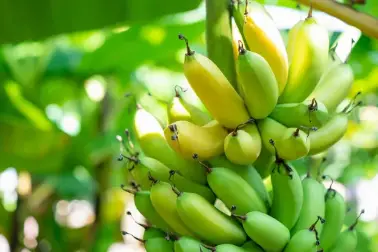The banana plant is a member of the Musaceae family and is an evergreen perennial plant.
It needs to be watered frequently during the growing season, but some of the methods for watering the plant are not ideal.
Banana plants are also known for being able to grow in a variety of conditions.
They are drought-resistant and can survive in different soil types.
However, they still need some care and attention to get them through the growing season.
One important factor that you have to keep an eye on is the amount of water your banana plant is getting.
However, in this post, we will look at signs of overwatering banana plants and how much water they really need.
What are the Signs of Overwatering?

signs of over-watering banana plant
Overwatering is a very common problem that banana plants have.
If you are worried about your banana plant, there are some signs to look for that can help you identify if your plant is overwatered or not.
If the soil is still moist but not wet, then your plant probably needs more water.
If the soil is wet and soggy, your plant probably needs less water.
Also, If your plant is looking wilted and its stem shows signs of drooping, then you need to pay attention to how much water you are giving your banana plant.
Signs of overwatering:
– The leaves turn yellow and start to wilt.
– The stem may be drooping, or the leaves may be curling up at the edges.
– The stem may be browning near the bottom of the stem.
How to Prevent Your Banana Plant from Over-Watering

Here’s how to prevent your banana plant from over-watering:
- – Make sure that the soil is dry before watering your banana plant.
- – Check for signs of water sitting in the soil or on top of the leaves
- – if it’s there, wait until it evaporates before watering again.
- – Separate your banana plant from other plants and give it plenty of room to grow.
- – Remember to water your banana plant early in the morning or in the evening when it will dry out faster.
How to prevent banana fruit from rotting:

- – Always peel bananas before eating them, so that the fruit doesn’t sit in wet messes of pulp for too long and causes decay.
- -Take the time to ensure that you’re giving your banana plant enough water and sunlight because they will help to speed up the ripening process.
- – Always make sure that the bananas you buy are firm, as soft, rotten fruit will provide a moist environment for all your other fruits and veggies to rot as well.
- – Keep your bananas in the refrigerator if you don’t eat them soon enough!- Use banana peels for banana bread, banana muffins, and banana pancakes.
What are The Best Ways to Water a Banana Plant?
One way to water a banana plant is by using a watering can.
The other option is to use a soaker hose that has been placed on top of the soil and underneath the leaves.
The best time to water your banana plant is when it’s dry – after about six hours or so.
One thing to consider when watering your banana plant is to make sure the water is at a good temperature.
If the water is too cold, it may cause the plant to be shocked and not be able to take up the water.
If this happens, don’t give up on your plant – try again in a few hours’ time.
Related: How long does sweet corn take to germinate
How to Know When Your Banana Plant is Over-Watering and How To Prevent It

Overwatering Banana Plants
The easiest way to know if your banana plant needs more water or less water is by checking the leaves.
If they’re dry, it’s time to water them again.
If they’re brown, it’s time to give them a break from watering for a while.
Check the leaves for signs of dryness.
If your banana plant is getting too much water or not enough water, it will show signs on the leaves.
If your banana plant is getting too much water, moist brown spots will appear on its leaves and they may even begin to rot.
This means that it’s time to either cut back on the amount of water you’re giving your banana plant or buy a new one.
If your banana plant is getting too little water, the leaves will appear wilted and dark green.
Finally
Banana plants need plenty of water in the beginning, but after about six weeks they need less than what they did at first and then again after about a month or so.
This should be followed by some hard pruning as well as regular watering for about two weeks before being completely dry for two weeks again.
Related: Orange Citrus Tree




